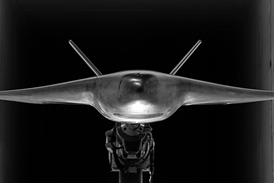1982 Garuda Indonesian Airlines takes delivery of its uniquely ordered A300B4-200s, the world's only two-crew conventional-cockpit wide-bodied type, which has a fully electro-mechanical (E-M) instrument fit but a "forward-facing crew-cockpit" (FFCC) employing the revolutionary "dark, quiet cockpit" (DQC) design philosophy. In the DQC, selector-switch lights turn off, when a system is switched on and illuminate, when the system is switched off or fails, so inoperative/failed systems are highly visible. When there are no failures, there are no distractions.
1983 A310 enters service. It has a FFCC/DQC with four-screen electronic flight-instrument system (EFIS), consisting of a primary flight display (PFD) and navigation display (ND) for each pilot (the PFD is located above ND), but a full-size E-M airspeed indicator, altimeter, VOR/ADF and vertical-speed-indicator flank the PFD and ND in their traditional positions. A revolutionary two-screen electronic centralised aircraft monitor (ECAM) presents systems status and mode diagrammatically, according to flight phase or situation - or as selected - and presents warnings in words. Engine instruments are E-M. There is electrical signaling for control of flaps, slats and spoilers/lift-dumpers. The flight deck is the same as for the A300-600, with crew type-rating commonality.
1988 A320 enters service. This is the world's first digital fly-by-wire (DFBW) airliner, with side-sticks instead of a control column. It has extensive automatic flight-envelope protection. Four laterally positioned, large-screen, EFIS displays, two-per-pilot with the PFD outboard of the ND, completely replace E-M flight instruments, except the standby set. Two large-screen ECAM displays are vertically mounted on the centre panel: the upper screen displays engine data and warnings, while the lower shows systems status. Display functions are transferable in case of screen failure. The A321 (which entered service 1994) and the A319 share cockpit layout and crew-type rating.
1993 The A340 and A330 enter service. These are the DFBW aircraft and they have the same cockpit layout, as that of the A320.
Source: Flight International























